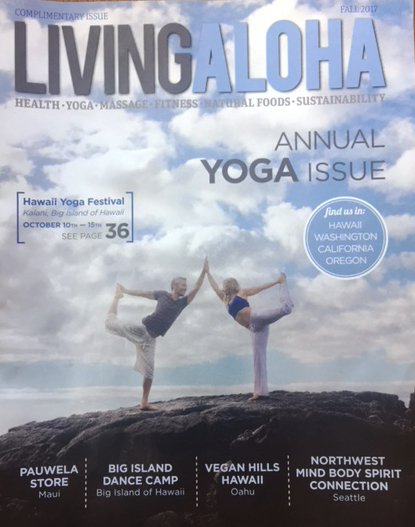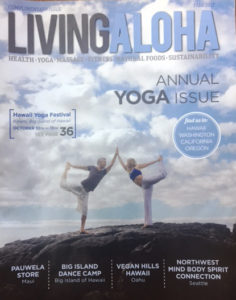Why do yoga?
We are born experiencing life from the inside out, through the vehicle of our bodies – our “earth suits”, as my friend, Harriet calls them. As babies, we laugh, and love, and breathe freely. But soon we become socialized, and learn to take our emotional and behavioral cues from others and our social environment. The mental and social filters that give us our adult perspective also reflect the wounds and prejudices of our parents, teachers, and peers. From this flawed, reflected perception we come to see ourselves as less-than, unworthy, or unlovable. That’s not the Truth, but our minds keep driving that misdirected bus. By the time we’re adults, we primarily experience life from the mind outward, disconnected from the Love and Source of our being. We experience our bodies as an after-thought rather than the vehicle of connection.
Roots of Yoga
Yoga, or a yoga-like practice, can take us back inside to where the love and connection are. Yoga is a Hindu spiritual and ascetic discipline that includes breath control, simple meditation, and the practice of specific bodily postures (asanas) for health and relaxation. From the Sanskrit word meaning to yoke, yoga is often translated as union, or connection. Whether it’s through gentle breathing or dynamic, flowing poses, conscious movement helps us make connections. (Other physical/esoteric practices such as tai chi, qi gong, Pilates, and Somatics, also use breath control, simple mediation, and specific physical movement/postures for health and relaxation. I include them in what I’m saying here about yoga.)
It’s hard to feel your knee or your hip from the inside when it’s immobile. But move it a little – especially while directing your breath and awareness into the area – and you can feel exactly how much it is stiff, sore, or flexible right now. On a very deep, esoteric (and sub-atomic) level, what we perceive as matter is movement. Movement is life.
Breath and Movement
The key is to bring your awareness to your movement and back into your body with your breath to live your life to its fullest. The emphasis in yoga is on breath and movement, even if it’s small or subtle. The practice is to feel the stretch, the movement of energy, and the connections – from within. You listen inwardly enough to feel and respect the edge of where you can move in that moment. The point of such practices is to wake up to who you are – physically, spiritually, mentally and emotionally – and connect to the life within and around you.
Think about it: you are a miracle. Your body is a miracle. Your body digests, laughs, feels, communicates with symptoms, repairs itself, …. all without you having to direct it. Any limitation it has is minor compared to what it can and does do. How often throughout the day do you tune in to this? When asking my clients to take a full belly breath and feel within, many of them have said something like: “Oh, you mean yoga breathing!” Many of them have only experience full, conscious breathing in a yoga class. Yes! The point of a yogic practice is to bring you (back) to the connected, loving, fully-breathing, non-judgmental state that is your birthright.
The Biggest Gift
Even though I took my first yoga class 35 years ago, I am still very much a beginner and it’s still a gift I give myself. I go to yoga classes to surrender my self-directedness for a while. It’s great to “be exercised” because I don’t always do those 20 extra leg lifts on my own. It’s an opportunity to tune inward and listen to what my body is feeling that day and pay attention to my breath in that moment. Yet the hardest part for me is holding my inner awareness enough that I don’t injure myself.
For me, staying tuned inward, and letting the instructions be suggestions rather than commands is the practice in a class. I have a qi gong practice I do alone, but tuning in to hear my body’s signals louder than the external ones points to another mastery. Plus, it’s a double-edged sword, going to a class with people who can stretch further, bend deeper, and show me what’s possible, and also what I can’t do, by comparison. My mind has the habit of comparison. But it’s a habit I can relinquish, if I am aware.
Best Use of Attention
If I can use my powers of comparison to show me possibility and inspiration without judgment, and stay in my body with my breath-awareness, I can stay focused within on what my body is ready for, now. Few of us can put our bodies exactly into all of the classical asana shapes and my body is no exception. Some days my wrists simply can’t handle as many downward dog poses as the instructor directs, or I get ambitious trying to stretch further than my body can go in that moment. When I push myself beyond my limits, I hurt myself. Then I’m out of class for days or weeks and I loose the incremental fitness benefits of the practice. If I continue to pay attention even through that, the injury brings me back inside, slows me down, and humbles me. It becomes another gift.
An ongoing yoga (or similar) practice helps you tune in to the subtle changes in your body, mood, and condition from day to day and disconnect from the mental chatter and external focus that grips most of us, most of the time. Whether you practice yoga with others in a class, follow a video, or move and breathe completely on your own, if you pay attention from within as you move, you will feel more connected and better as a result.
Healing Catalyst, Denise LaBarre, LMT, has a hands-on healing practice on Maui. For body-emotional wisdom that helps you make your own internal healing connections, get her book, Issues in Your Tissues: Heal Body and Emotion from the Inside Out or go to her website: www.HealingCatalyst.com
*** This article first appeared in Living Aloha Magazine, Fall 2017. www.livingaloha.net
Better yet!
For more body-emotion insights and information + stories, exercises and cartoons, get your copy of Issues in Your Tissues today!


